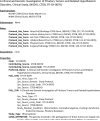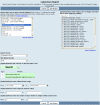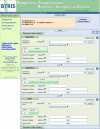The National Institutes of Health's Biomedical Translational Research Information System (BTRIS): design, contents, functionality and experience to date
- PMID: 24262893
- PMCID: PMC4026354
- DOI: 10.1016/j.jbi.2013.11.004
The National Institutes of Health's Biomedical Translational Research Information System (BTRIS): design, contents, functionality and experience to date
Abstract
The US National Institutes of Health (NIH) has developed the Biomedical Translational Research Information System (BTRIS) to support researchers' access to translational and clinical data. BTRIS includes a data repository, a set of programs for loading data from NIH electronic health records and research data management systems, an ontology for coding the disparate data with a single terminology, and a set of user interface tools that provide access to identified data from individual research studies and data across all studies from which individually identifiable data have been removed. This paper reports on unique design elements of the system, progress to date and user experience after five years of development and operation.
Keywords: Clinical research; Ontology; Research data repository; Research data warehouse; Translational research.
Published by Elsevier Inc.
Figures








Similar articles
-
The clinical research data repository of the US National Institutes of Health.Stud Health Technol Inform. 2010;160(Pt 2):1299-303. Stud Health Technol Inform. 2010. PMID: 20841894 Free PMC article.
-
Adapting a Clinical Data Repository to ICD-10-CM through the use of a Terminology Repository.AMIA Annu Symp Proc. 2014 Nov 14;2014:405-13. eCollection 2014. AMIA Annu Symp Proc. 2014. PMID: 25954344 Free PMC article.
-
Normalization of Phenotypic Data from a Clinical Data Warehouse: Case Study of Heterogeneous Blood Type Data with Surprising Results.Stud Health Technol Inform. 2015;216:559-63. Stud Health Technol Inform. 2015. PMID: 26262113 Free PMC article.
-
Facilitating biomedical researchers' interrogation of electronic health record data: Ideas from outside of biomedical informatics.J Biomed Inform. 2016 Apr;60:376-84. doi: 10.1016/j.jbi.2016.03.004. Epub 2016 Mar 10. J Biomed Inform. 2016. PMID: 26972838 Free PMC article. Review.
-
Transdisciplinary translational behavioral (TDTB) research: opportunities, barriers, and innovations.Transl Behav Med. 2016 Mar;6(1):32-43. doi: 10.1007/s13142-015-0367-3. Transl Behav Med. 2016. PMID: 27012251 Free PMC article. Review.
Cited by
-
A comprehensive study of mobility functioning information in clinical notes: Entity hierarchy, corpus annotation, and sequence labeling.Int J Med Inform. 2021 Mar;147:104351. doi: 10.1016/j.ijmedinf.2020.104351. Epub 2020 Dec 24. Int J Med Inform. 2021. PMID: 33401169 Free PMC article.
-
Pharmacogenomics Implementation at the National Institutes of Health Clinical Center.J Clin Pharmacol. 2017 Oct;57 Suppl 10(Suppl 10):S67-S77. doi: 10.1002/jcph.993. J Clin Pharmacol. 2017. PMID: 28921647 Free PMC article. Review.
-
Tumour spectrum in AKT1-related Proteus syndrome: a systematic review of clinical reports and series.J Med Genet. 2025 Jan 27;62(2):74-81. doi: 10.1136/jmg-2024-110173. J Med Genet. 2025. PMID: 39643433 Free PMC article.
-
Integrative LHS for precision medicine research: A shared NIH and Taiwan CIMS experience.Learn Health Syst. 2018 Oct 17;3(1):e10071. doi: 10.1002/lrh2.10071. eCollection 2019 Jan. Learn Health Syst. 2018. PMID: 31245594 Free PMC article.
-
Characterizing Basic and Complex Usage of i2b2 at an Academic Medical Center.AMIA Jt Summits Transl Sci Proc. 2020 May 30;2020:589-596. eCollection 2020. AMIA Jt Summits Transl Sci Proc. 2020. PMID: 32477681 Free PMC article.
References
-
- Cimino JJ, Munson PJ, Lewis T, Rodbard D. Graphical Display of Patient Data Using a Desk-Top Computer. In: Heffernan HG, editor. Proceedings of the Fifth Annual Symposium on Computer Applications in Medical Care. Washington, D.C.: Oct, 1981. pp. 1085–1088.
-
- NIH Videocast BTRIS Town Hall Meeting; February 28, 2008; [July 29, 2013]. http://videocast.nih.gov/summary.asp?Live=6575.
Publication types
MeSH terms
Grants and funding
LinkOut - more resources
Full Text Sources
Other Literature Sources

